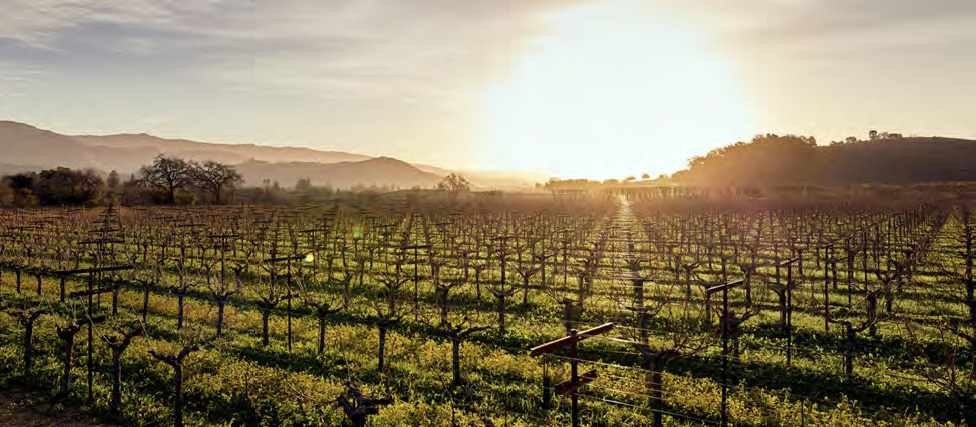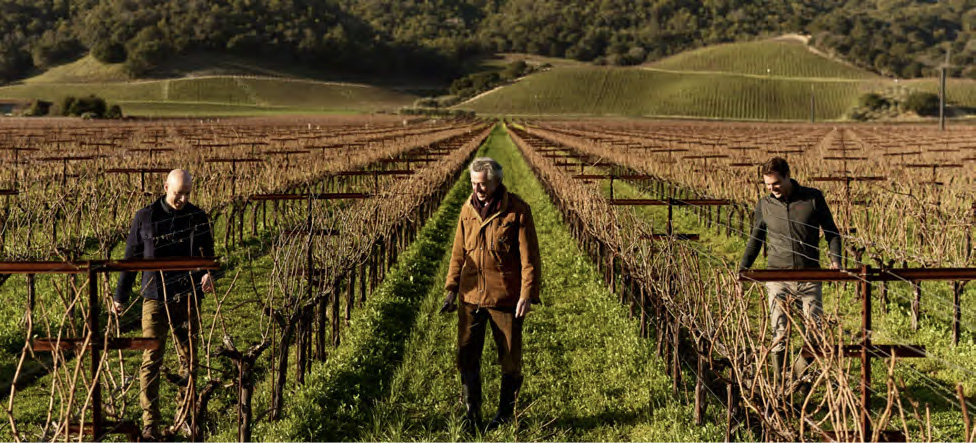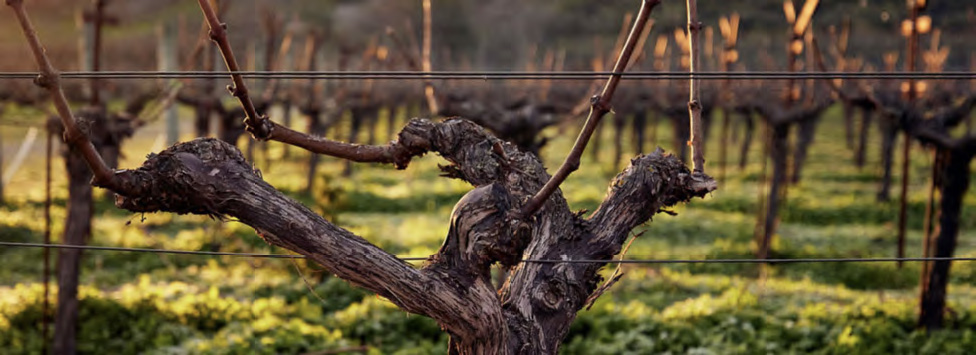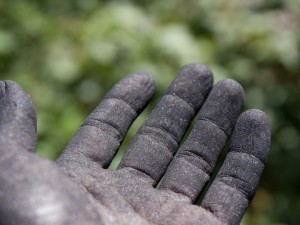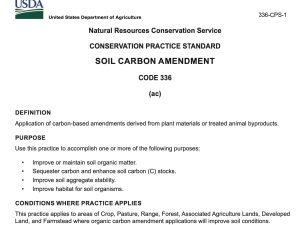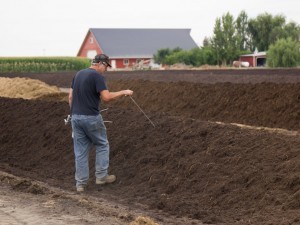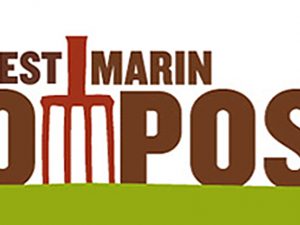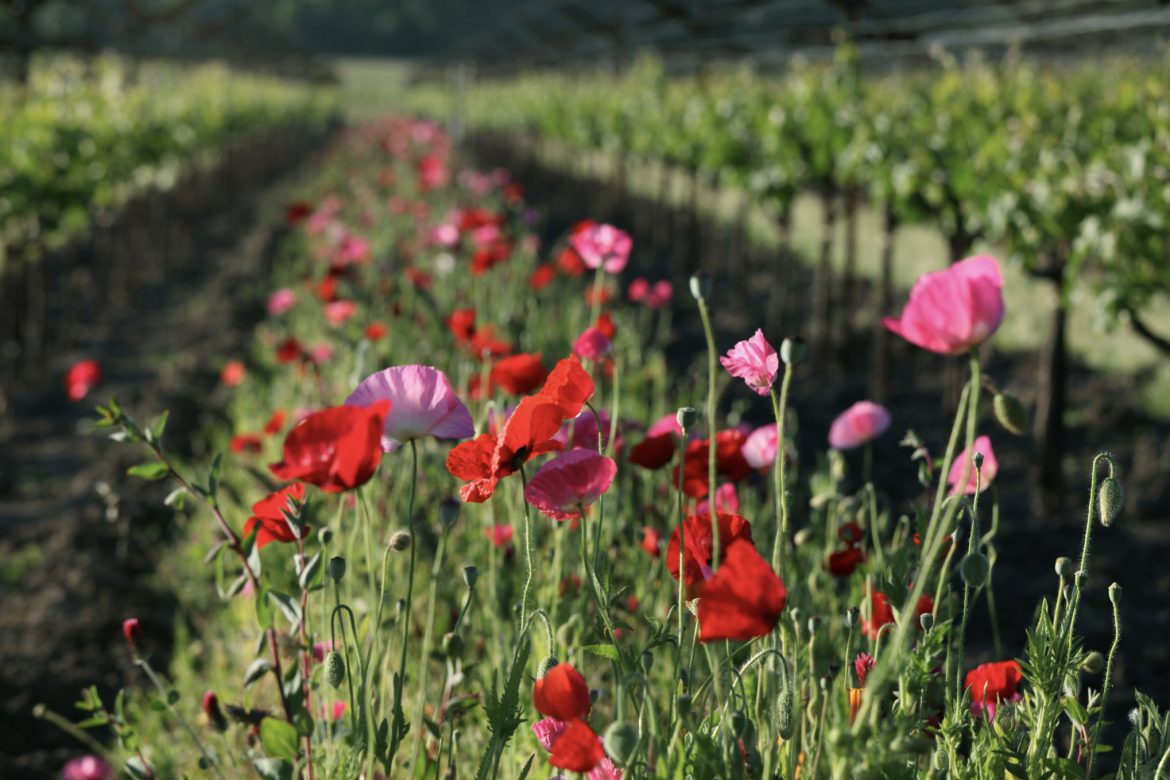
Cover photo caption and credits
Aesthetic and pollinator-friendly cover crop between vine rows at Dominus Estate. Photo credited to Dominus Estate
Key Quote
“It was shocking to see the crumbly texture holding so much water when it was like concrete before”
– Guillaume Eicholz, Vineyard Director for Dominus Estate
Credits
Written by Charlie McIntosh of Pacific Biochar Benefit Corporation
Describing the work done by Guillaume Eicholz and the vineyard team at Dominus Estate
All photos credited to Dominus Estate
BACKGROUND
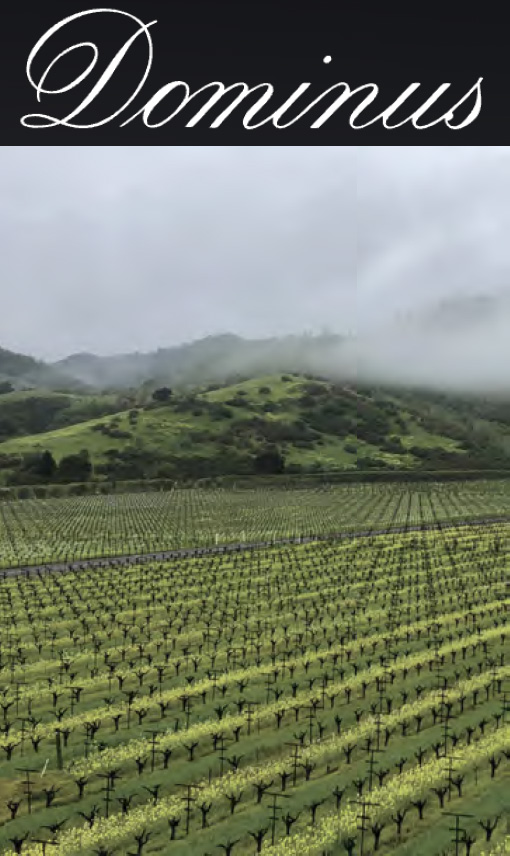
Photo credited to Dominus Estate
Dominus Estate is a world-class wine producer in Napa Valley, CA with carefully curated vineyards covering 102 acres of their 134 acre home ranch, the Napanook vineyard, where they celebrate the rich history of the land with a commitment to sustainability and stewardship. Dominus has already implemented a suite of practices, including dry-farming, that benefit the native ecology and wine quality while being focused on continuous improvement. In their own words:
“Wine is the product of a living ecosystem. Each decision we take in the vineyard determines the quality of the wine. We constantly refine our viticultural practices to adapt to evolving climate conditions. We are committed to creating a place where grapevines, wildlife, vegetation and man can thrive together for generations to come.”
Napa Valley boasts some of the most premiere vineyards and wineries in the world, with Dominus Estate recognized as among the top producers in the region. Many viticulturalists attribute the success of the region to its unique soils and climate that combine beautifully to shape the iconic terroir. Despite these near ideal conditions, generations of intensive agriculture have left their mark on the region’s soils making some vineyard blocks more productive than others when it comes to producing some of the highest quality wines in the world. Under the watchful eye of Vineyard Director Guillaume Eicholz one particular 6-acre dry-farmed vineyard block, located near the entrance to the new wine-making facility on Napa Nook Road, had struggled to produce at the level of Dominus’ world-class wines. Guillaume describes the soil as a “sticky grey clay” that transforms into a concrete-like crust during the long hot dry season and limits water availability to the thirsty vines. Dry-farming relies solely on precipitation during the wet winter season to supply all of the water needs for the vineyard during the hot dry summer when it isn’t uncommon to see 3-4 months without any rain. Soil structure is sensitive to excessive tillage during conditions that are too wet or too dry leading to the collapse of soil pores, surface crusting, and compaction that limit water’s ability to infiltrate and be stored in the soil profile. Tillage activities can also generate significant amounts of dust.
Dust is so well known in Napa Valley, CA that locals often use the term “Rutherford Dust” to describe the hazy clouds that are stirred up each fall as growers prepare for the coming rainy season. In many dry-farmed vineyards tillage is used as an important tool at the end of the dry season to “open up” the soil before the rainy season delivers much needed moisture to the region. The intended goal is to encourage rainwater to infiltrate better into the soil, however, many vineyards are recognizing that this may not always be the case. In 2022, facing a challenging season of crop losses Guillaume Eicholz decided to test the common practice of fall tillage by leaving a section of the vineyard un-tilled with residues left intact on the soil surface. Contrary to the traditional belief, what he observed at this site was increased pooling and runoff in the tilled area with significantly less water infiltrating into the soil. This was enough to convince him of the need to implement a suite of regenerative practices, including applications of biochar and compost, with the goal of improving the soil’s water infiltration rate and water holding capacity without the use of tillage.
PROJECT GOALS
Improve Soil Structure
Evidence of surface crusting, compaction, aggregate instability, and limited porosity are all signs of poor soil structure that severely limit crop production and crop quality.
Improve Water Availability
Restricted water infiltration and percolation can severely limit a soil’s ability to rapidly soak up and store water during precipitation events, dramatically reducing the water that is available to crops during the dry season. This is especially limiting to dry-farming operations that rely entirely on precipitation as the only source of irrigation water for the growing crop.
Reduce Tillage & Dust Generation
Dust is often generated from tillage activities performed when the soil is too dry and can lead to undesirable losses of windblown topsoil as well as reduced air quality. Excessive or untimely tillage can negatively impact soil structure, making it challenging for water to infiltrate and move through the soil profile, reducing water availability during the dry season.
MANAGEMENT PRACTICES
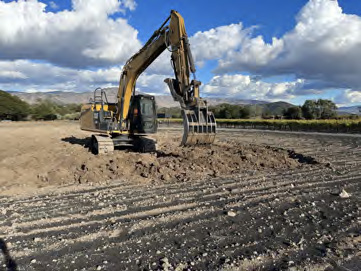
Photo credited to Dominus Estate
Biochar + Compost
Soil carbon amendments are blended and spread as a broadcast application during the ground preparation phase of the vineyard re-development, which involves removing roots from the ground with an excavator. Dominus’ Vineyard team took advantage of the excavator use during re-development to bury the biochar and compost. It is otherwise not in the Dominus philosophy to deep plow soil, particularly with an excavator. Wood biochar with a carbon content of 85%, sourced from Pacific Biochar, is applied at a rate of 25 tons/acre (equivalent to 0.22% SOM at depth of cultivation) and dairy manure compost, produced by Poncia Fertilizer Inc., is applied at 5 tons/acre. After spreading, amendments are incorporated to a depth of 12” using a disc and to 36” using a soil comb.
See the “Important notes on application rate of biochar” section below for more information on biochar application rates.
Cover Crops
Immediately after the biochar + compost amendments have been applied and incorporated, the vineyard re-development block is seeded to a cover crop mix that will keep the soil covered and living roots growing during the fallow period prior to planting vines. Cover crops will be allowed to establish and grow through the wet winter season and will be terminated by crimping to form a mulch layer during the dry summer season. This practice can reduce the need for cultivation to manage weed pressure and the combination of living roots and a mulch layer allow for better infiltration of water during the rainy season, reduced surface crusting, and dust generation during the dry season.
BIOCHAR + COMPOST APPLICATION
Site Description
- Dominus Estate
- 2570 Napa Nook Rd, Yountville, CA 94599
- Vineyard Block: 6 acres (re-development)
- Groundwork completed Fall/Winter 2022 by Pina Vineyard Management Company
- Planting scheduled for Spring 2025
- Rootstocks: 110R & 101-14
- Scions: Cabernet Sauvignon & Cabernet Franc
Soils Information (from UC Davis SoilWeb)
- Link to SoilWeb
- Soil Series: Haire
- The Haire series is a member of the clayey, mixed, thermic family of Typic Haploxerults. Typically, Haire soils have gray and grayish brown, neutral or slightly acid, light clay loam A horizons, pale brown, strongly acid, clay B2t horizons, and pale yellow, strongly acid, gravelly clay loam C horizons.
- CA Storie Index: Grade 1 – Excellent (81.3)
- Land Capability Class (non-irrigated): 3-e3
- Ecological Site Description: CLAYPAN
Application Rate
- Biochar applied at 25 tons/acre
- Blacklite Pure, produced by Pacific Biochar Benefit Corporation in Humboldt county, CA from softwood forestry/sawmill residues, 85% organic carbon content
- See the “Important notes on application rate of biochar” section below for more information on biochar application rates.
- Compost applied at 5 tons/acre
- Dairy manure compost, produced by Poncia Fertilizer Inc. in Santa Rosa, CA
Application Methods
- Biochar is delivered to a local compost yard where it is blended with compost at the correct ratio
- Biochar + compost blend is delivered to the site and spread evenly as a broadcast application over the 6 acre vineyard block
- Biochar + compost blend is incorporated to a depth of 12” using a disc and to 36” using a soil comb.
IMPORTANT NOTES ON APPLICATION RATES OF BIOCHAR
While it is common for application rate to be expressed as tons per acre (two dimensional) for ease of communication, it can be very useful to take the extra step and determine the application rate with consideration of the area cultivated and depth of cultivation (three dimensional). This makes successful applications in one field more easily transferable to another field with different cultivation practices.
Pacific Biochar has developed a downloadable excel file, the Biochar Application Rate Calculator, for exactly this purpose, which can be found for free download on this web page – https://pacificbiochar.com/biochar-application-rate-calculator/ –
Biochar is naturally found in soil as part of Soil Organic Matter (SOM), and globally makes up about 14% of the total SOM on average (Reisser, M., et al.,: Pyrogenic Carbon in Soils: A Literature-Based Inventory and a Global Estimation of Its Content in Soil Organic Carbon and Stocks, Front. Earth Sci., 2016.). This is an additional reason to consider biochar applications in terms of their impact on total SOM – it helps tie into a vast body of knowledge.
“We found that global PyC [pyrogenic carbon, biochar] represent on average 13.7% of the SOC and can be even up to 60%, making it one of the largest groups of identifiable compounds in soil, together with polysaccharides.”
– Reisser, M., et al.,: Pyrogenic Carbon in Soils: A Literature-Based Inventory and a Global Estimation of Its Content in Soil Organic Carbon and Stocks, Front. Earth Sci., 2016.
The application of biochar, at a rate of 25 tons/acre cultivated down to 36” depth, results in a Soil Organic Matter (SOM) increase of approximately 0.22% in the area cultivated, as calculated with the Biochar Application Rate Calculator (tons biochar per acre * SOM content of biochar / mass of soil cultivated).
 Screen shot from Pacific Biochar’s Biochar Application Rate Calculator
Screen shot from Pacific Biochar’s Biochar Application Rate Calculator
It can be expected that, with the excavator technique used, the biochar material was more concentrated in the upper ⅔ of the profile that was cultivated, the top 24”. If we look at the same application rate of 25 tons per acre but assume most of the biochar remained in the top 24”, the SOM increase in that area would be approximately 0.33%.
 Screen shot from Pacific Biochar’s Biochar Application Rate Calculator
Screen shot from Pacific Biochar’s Biochar Application Rate Calculator
Therefore, the application rate of biochar in this vineyard can be expressed as an SOM equivalent of about 0.22% to 0.33%. This choice of application rate at Dominus Estates was made with SOM impact in mind, and the tools noted above were used in that process.
As context, in a long-standing and highly successful field trial at Oasis Vineyard, the application rate of biochar was 10 tons per acre applied down the planting row only, resulting in an SOM equivalent of about 0.43% in the area cultivated.
For general discussion and suggestions on biochar application rates, and to find the Biochar Application Rate Calculator, you can look to Pacific Biochar’s web page here, Several Ways to Use Biochar.
PRELIMINARY RESULTS
In fall/winter of 2022, earthworks were completed on the 6 acre vineyard re-development block by Pina Vineyard Management and a cover crop was seeded to ensure the soil remained covered and protected during the rainy season. The following year, in summer of 2023, the Dominus team dug a soil profile pit down to 36” to assess the impacts on soil structure and water availability. The top 6” of the soil profile had formed the familiar crust in areas where the soil was not covered with residues. However, below 6” revealed clearly visible biochar particles dispersed in the deeper layers of the soil profile evidently still holding moisture well into the dry season.
After the second year of fallowing with a cover crop the soil profile was examined again in summer of 2024. Guillaume and the Dominus team were so impressed by the dramatic change in soil structure that, in fall of 2024, the decision was made to apply a compost-heavy blend of compost + biochar on all of the established vineyards on the 134 acre ranch. The established vineyard blocks each received 2-5 tons/acre of a compost-heavy blend (80% compost, 20% biochar) that was incorporated into the top few inches before seeding to a winter cover crop.
“It was shocking to see the crumbly texture holding so much water when it was like concrete before”
– Guillaume Eicholz, Vineyard Director for Dominus Estate
Back on the 6 acre re-development block, rootstock vines are scheduled to be planted in spring 2025 and Guillaume has plans to continue using biochar + compost in conjunction with the cover crop program. In two years, the combination of soil health management practices implemented at Dominus have demonstrated that significant improvements in soil structure and water availability are possible in a short timeframe in these clayey soils. The next phase of this project will be to observe how the newly planted vines perform in the improved vineyard block and to continue monitoring changes in the soil health status.
To learn more about this project and how applications of biochar can improve soil health, please reach out to Pacific Biochar.

